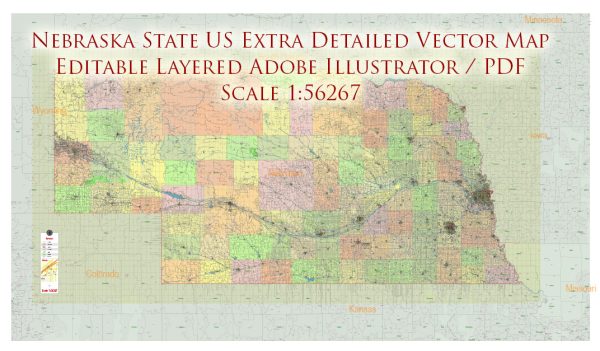Nebraska is a state located in the Great Plains region of the United States, and it offers a diverse and unique natural landscape. While it might not be as well-known for its natural beauty as some other states, it has its own charm and a wide range of natural features to explore. Here’s a description of Nebraska’s state nature:
- Prairies: Nebraska is often referred to as the “Cornhusker State” because of its vast agricultural landscapes. The state is renowned for its expansive prairies, with native grasses and wildflowers. The Sandhills region in the western part of the state is especially known for its rolling sand dunes covered in prairie grasses.
- Missouri River: The Missouri River flows along the eastern border of Nebraska. It is a significant natural feature, offering opportunities for boating, fishing, and wildlife viewing. The river’s floodplains are essential for a variety of plant and animal species.
- Lakes and Reservoirs: Nebraska boasts numerous lakes and reservoirs, both natural and man-made. Some of the most popular include Lake McConaughy, Harlan County Reservoir, and Lewis and Clark Lake. These bodies of water are ideal for fishing, water sports, and camping.
- Wildlife: Nebraska’s diverse ecosystems support a rich array of wildlife. The state is known for its birdwatching opportunities, with Sandhill cranes being a popular sight during their annual migration. You can also find deer, pronghorn antelope, bison, and other wildlife in various regions.
- State Parks: Nebraska has a range of state parks that showcase the state’s natural beauty. Some of the notable ones include Chadron State Park, Mahoney State Park, and Ponca State Park. These parks offer camping, hiking, and recreational activities amidst scenic surroundings.
- Badlands: In the northwestern part of the state, you can find unique badlands formations, such as those in Toadstool Geologic Park. These otherworldly landscapes are perfect for hiking and photography.
- Pioneer History: While not strictly part of nature, Nebraska has significant historical sites, particularly related to westward expansion and pioneer history. Places like Chimney Rock and Scotts Bluff National Monument are not only historically important but also offer stunning views of the surrounding landscapes.
- Geological Diversity: Nebraska also boasts geological diversity. In the northeast, you can find the Niobrara River Valley, with its distinctive sandstone formations and opportunities for canoeing and fossil hunting.
- Forest and Grassland Areas: Although Nebraska is often associated with prairies, there are forested areas as well. The Pine Ridge region in the northwestern part of the state is characterized by rolling hills and forests. Bessey Ranger District in the Nebraska National Forest is known for its Ponderosa pines.
- Star Gazing: Due to its low light pollution in many areas, Nebraska is an excellent place for stargazing. The Sandhills, in particular, offer some of the darkest skies in the United States, making it a prime location for astronomers and night sky enthusiasts.
Nebraska’s natural beauty may be less well-known than some other states, but it offers a variety of outdoor activities and scenic landscapes for nature lovers and adventurers to explore.


 Author: Kirill Shrayber, Ph.D.
Author: Kirill Shrayber, Ph.D.